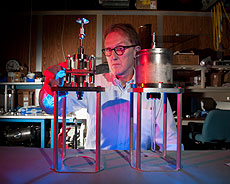Bubbles and dark matter
 |
| Fermilab scientist Mike Crisler adjust a component of the CIRTE experiment. The tiny bubble chamber (glass tube on lower right) will aid in the dark matter search. Photo: Reidar Hahn
|
In a deep underground laboratory, scientists are hard at work on one of the most advanced experiments in particle physics: watching bubbles form.
More than soap bubbles, these delicate reactions may point the way to the first definitive signs of dark matter.
The idea is simple: when a particle associated with dark matter passes through the superheated liquid, it can slam into an iodine nucleus and forms a bubble – as if boiling water one bubble at a time. COUPP, the Chicagoland Observatory for Underground Particle Physics, operates two chambes using this system. A 4 kg chamber is housed deep within a mine at the Canadian laboratory, SNOLAB. A 60 kg chamber will move there later this year. Being underground provides better shielding from cosmic rays.
The key to bubble chambers is to take a technology that's been around for decades and make it more precise. This is where CIRTE comes in. Called the COUPP Iodine Recoil Threshold Experiment, CIRTE is finding the exact conditions for when that bubble will form.
Peter Cooper, the physicist heading CIRTE, pointed out that Fermilab's first experiment began the same way more than 30 years ago in the same facility and with some of the same equipment.
"When I was a postdoc, I studied this," Cooper said. "And I remembered how to do it. So I went back and did it."
Aria Soha, manager of the Fermilab Test Beam Facility, watched as Cooper replayed shots of the reactions in the pen-sized chamber mounted within the particle beamline on a monitor.
"You've got a double bubble," said Soha.
In the images, three dots burst like popcorn into bubbles.
"A triple," Cooper corrected.
Mike Crisler, a Fermilab scientist involved with COUPP, was also watching the images.
"At the moment of their birth, they're incredibly tiny," said Crisler. "It's a calibration that's of enormous technical value."
By raising the sensitivity of COUPP, CIRTE will increase the chances of experimenters detecting iodine interactions with dark matter particles – called Weakly Interacting Massive Particles, or WIMPs. The goal of calibration experiments like CIRTE is for the bubble to be so distinct that scientists can actually differentiate WIMP interactions from background events just by listening to the sound of the bubble.
In studying WIMPS, scientists hope to find out how dark matter dominates a universe that is just four percent visible matter.
"Dark matter particles are the galaxy," Cooper explained. "We're just the dirt sprinkled within it."
—Brad Hooker
|